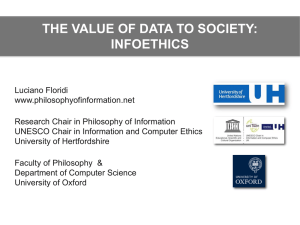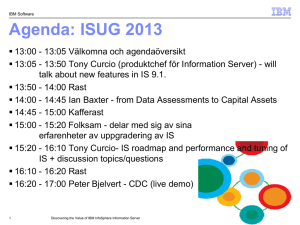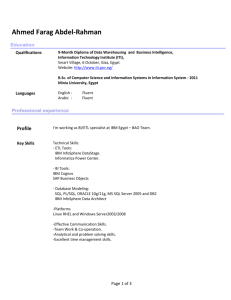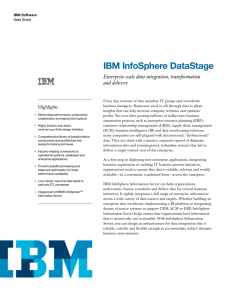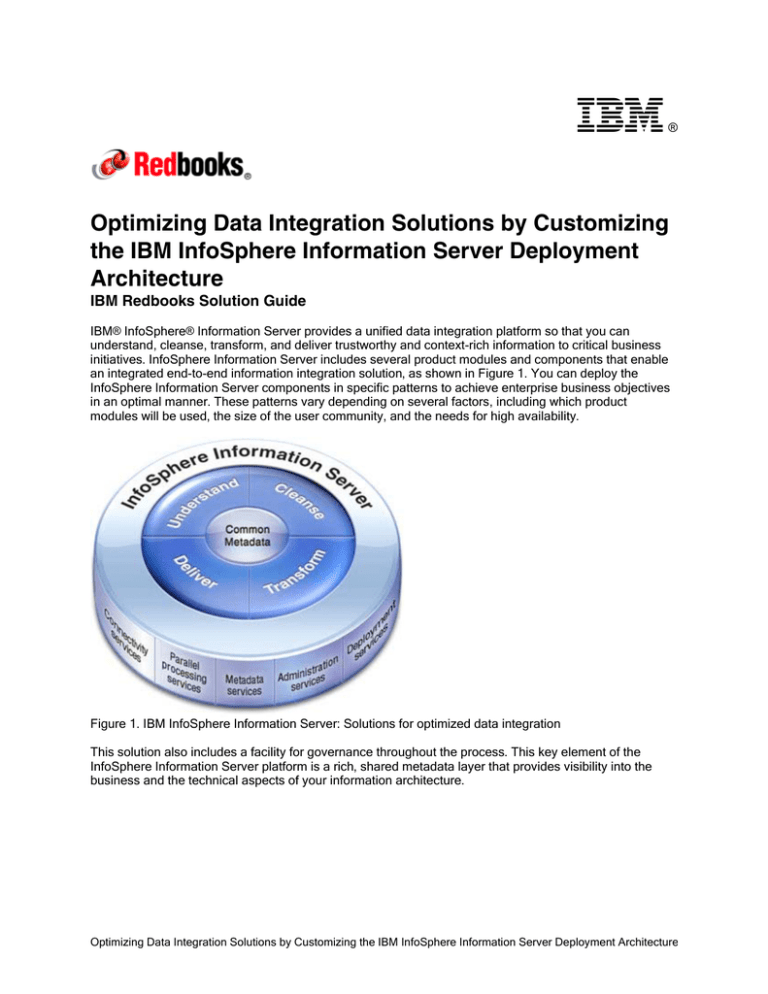
®
Optimizing Data Integration Solutions by Customizing
the IBM InfoSphere Information Server Deployment
Architecture
IBM Redbooks Solution Guide
IBM® InfoSphere® Information Server provides a unified data integration platform so that you can
understand, cleanse, transform, and deliver trustworthy and context-rich information to critical business
initiatives. InfoSphere Information Server includes several product modules and components that enable
an integrated end-to-end information integration solution, as shown in Figure 1. You can deploy the
InfoSphere Information Server components in specific patterns to achieve enterprise business objectives
in an optimal manner. These patterns vary depending on several factors, including which product
modules will be used, the size of the user community, and the needs for high availability.
Figure 1. IBM InfoSphere Information Server: Solutions for optimized data integration
This solution also includes a facility for governance throughout the process. This key element of the
InfoSphere Information Server platform is a rich, shared metadata layer that provides visibility into the
business and the technical aspects of your information architecture.
Optimizing Data Integration Solutions by Customizing the IBM InfoSphere Information Server Deployment Architecture
Did you know?
Enterprise data volumes are growing. In addition, the number of data sources, the number of consumers,
and the number of integration points are growing, making information integration and governance more
important than ever before. Integrating your data assets and managing them proactively with a strong
data governance program are key enablers for achieving your business goals and for gaining a significant
competitive advantage to keep your business growing and profitable.
Business value
Thousands of organizations are employing the powerful components of the IBM InfoSphere Information
Server. As a result, they have access to the current and accurate information they need for key business
decisions that are delivered through this high performance data integration platform. In addition,
InfoSphere Information Server generates key metadata as a by-product of development activities to
populate the shared metadata repository and to enable organizations to maximize their reporting
capabilities.
IBM InfoSphere Information Server provides a single unified platform that companies use to understand,
cleanse, transform, and integrate their data sources to deliver trustworthy and context-rich information. It
is built on a multitiered platform that includes a suite of product modules and components that focus on
information integration. Furthermore, it can integrate with other third-party applications to enable the use
of information, wherever it exists in the enterprise.
As examples, the following component modules can be part of an InfoSphere Information Server solution:
IBM InfoSphere Blueprint Director
IBM InfoSphere Business Glossary
IBM InfoSphere DataStage®
IBM InfoSphere FastTrack
IBM InfoSphere Information Analyzer
IBM InfoSphere Metadata Workbench
IBM InfoSphere QualityStage®
In addition, a solution can include the following integrally related applications:
InfoSphere Discovery
InfoSphere Data Architect
InfoSphere Data Replication
InfoSphere Information Server delivers trustworthy information and supports information governance
objectives with advanced capabilities built on a highly scalable, security-rich, and robust data integration
platform that is designed to simplify your data integration needs. It addresses the demanding information
needs of organizations and improves the operational management and governability of integration
projects and information infrastructure.
InfoSphere Information Server can provide the following benefits:
Fully integrated platform (common metadata foundation)
Proven performance and scalability
Enablement of business and IT collaboration
On-time delivery by using a reusable approach to delivery
Implementation of proven practices across shared teams and workstreams
Collaboration on the design before action is taken
InfoSphere Information Server supports a wide range of initiatives, including business intelligence, master
data management, infrastructure rationalization, business transformation, and risk and compliance
(governance).
Optimizing Data Integration Solutions by Customizing the IBM InfoSphere Information Server Deployment Architecture
Solution overview
For successful deployment of InfoSphere Information Server components in typical logical infrastructure
topologies that use the shared metadata capabilities of the platform, you must follow the guidelines and
criteria. The guidelines support the requirements for development lifecycle, data privacy, information
security, high availability, and performance. The objective is to help you evaluate your own information
requirements to determine an appropriate deployment architecture. It can help you fulfill specific use
cases and effectively use the functionality of the InfoSphere Information Server product modules and
components.
InfoSphere Information Server consists of a robust, scalable, server architecture that is built on three
distinct components or functional tiers:
Services tier. A Java Platform, Enterprise Edition (Java EE) application server.
Repository tier. A metadata database, known as the Information Server repository tier.
Engine tier. A parallel processing runtime framework.
In addition, InfoSphere Information Server has a client tier that consists of thin and rich client product
modules. Both the application server and the database server are standard server applications. Figure 2
shows a high-level view of the InfoSphere Information Server architecture.
Figure 2. IBM InfoSphere Information Server architecture
One of the key advantages of InfoSphere Information Server is the shared infrastructure for all the
individual InfoSphere Information Server product components. This shared infrastructure enables
integration of all these components, minimizing duplicate effort and maximizing reuse. In addition,
InfoSphere Information Server integrates metadata from external applications with other metadata in its
repository. This way, the InfoSphere Information Server product modules can each use this external
metadata to achieve the business objectives.
Optimizing Data Integration Solutions by Customizing the IBM InfoSphere Information Server Deployment Architecture
The product modules provide business and technical functionality throughout the entire initiative, from the
planning through design phases to the implementation and reporting phases. Each product module uses
the repository for its own persistence layer, yet its only access to the repository is through the IBM
WebSphere® Application Server repository service. WebSphere Application Server is configured at
installation time to access the repository through its Java Database Connectivity (JDBC) layer, based on
the credentials that are passed to it during the installation. This approach is one way that InfoSphere
Information Server ensures the integrity and security of its data and metadata.
InfoSphere Information Server has a unique, metadata-driven design that helps to align business goals
and IT activities. It provides consistent terms and rules, and it captures business specifications. These
specifications are used to automate development tasks, helping you gain greater insight to data by
tracking its lineage. Some deployment architectures for these types of implementations might introduce
challenges in fully using the shared metadata platform across products, environments, and servers.
Furthermore, data privacy and information security requirements add other levels of complexity.
Fortunately, InfoSphere Information Server supports a wide range of implementation topologies from a
basic single computer to highly available clusters and grid configurations. They satisfy your requirements
and enable the robust and high performing solutions for your particular environment.
Solution architecture
IBM InfoSphere Information Server has several installation topologies that you can implement in any
solution. They range from a basic single computer to highly available clusters and grid configurations.
Each topology considers the deployment architectures for each of the major software subsystem
components (tiers) of InfoSphere Information Server in combination and individually. However, the focus
is constrained to the perspective of a single, overall installation environment, such as development, test,
or production. The following topologies and related topics are available:
Single computer
Client server
Dedicated computer per tier
Dedicated engine
Clusters
Active-passive
Massively parallel
Grid
Web services
Disaster recovery
Optimizing Data Integration Solutions by Customizing the IBM InfoSphere Information Server Deployment Architecture
Figure 3 illustrates the InfoSphere Information Server solution architecture for implementing the
topologies.
Figure 3. IBM InfoSphere Information Server solution architecture
All InfoSphere Information Server product modules generate and consume metadata. The generated
metadata is persisted in the InfoSphere Information Server repository. Through this shared InfoSphere
Information Server repository, InfoSphere Information Server provides collaboration between the product
modules and users, such as analysts, data stewards, subject matter experts, and developers. This
behavior is true for all InfoSphere Information Server instances, such as development, test, production, or
other environments that a company might have. However, the development lifecycle varies for the
InfoSphere Information Server assets, such as InfoSphere DataStage job design (extract, transfer, and
load (ETL) program) and data source technical metadata.
The lifecycles of the InfoSphere Information Server assets have an impact on the deployment architecture
for the InfoSphere Information Server product modules. Depending on business requirements, InfoSphere
Information Server product modules might be deployed in some or all of the environments. The same
product module can also be deployed differently, based on the feature and the level of metadata
collaboration that you are using. Therefore, the typical development, test, and production deployment
architecture might not be appropriate for each of the InfoSphere Information Server product modules and
business use-case scenarios.
Optimizing Data Integration Solutions by Customizing the IBM InfoSphere Information Server Deployment Architecture
You need to consider various factors when you choose the deployment architecture for InfoSphere
Information Server. To effectively use the InfoSphere Information Server product modules and achieve
the business objectives, you can select one of the four deployment architectures. But which one should
you choose? The following architectures are available:
Simple. The typical development, test, and production environment architecture. In a typical
deployment architecture, the source code is developed in the development environment, tested and
deployed to the test environment, and then tested and deployed to the production environment.
Unified. A combination of development, metadata reporting, and a collaboration environment.
Reporting. Has a dedicated metadata environment to provide all stakeholders full-time access to the
various types of metadata (business and technical) that exist within InfoSphere Information Server.
Governance. External metadata can be analyzed and reported, and an enterprise glossary can be
created or shared to increase governance in your company.
Development of InfoSphere DataStage and InfoSphere QualityStage fits into this typical development
lifecycle. An important consideration is to size the production environment appropriately so that data
integration processing is not negatively affected by any other processes because the main purpose of the
production environment in this case is data integration. When you use other InfoSphere Information
Server product modules, such as InfoSphere Information Analyzer, InfoSphere FastTrack, InfoSphere
Business Glossary, and InfoSphere Metadata Workbench with InfoSphere DataStage and InfoSphere
QualityStage, consider whether you need to dedicate separate capacity for these other modules.
Deciding which architecture to choose
To help you decide which of the four deployment architectures is the best one for your environment,
consider the following main determining factors:
Which products are you using?
Do you have metadata collaboration (reuse of metadata for other purposes) between multiple
products?
How many users will do lineage, impact analysis, and use the glossary?
How intricate is your glossary?
What is your environment capacity?
Optimizing Data Integration Solutions by Customizing the IBM InfoSphere Information Server Deployment Architecture
The following process assesses the architecture and deployment environments:
1. Using the decision chart in Figure 4, determine an appropriate deployment architecture (how many
and which kinds of environments are required to support the product mix).
2. Determine in which environment to deploy each of the product modules.
3. Evaluate the requirements for high availability.
4. Design a topology that is based on business and IT requirements, availability, and product mix for
each environment.
Figure 4. Architecture decision flow chart
Optimizing Data Integration Solutions by Customizing the IBM InfoSphere Information Server Deployment Architecture
The InfoSphere Information Server tiers are available on the following platforms:
The installable client tier components, which provide the user interface, are available only on
Microsoft Windows platforms. Business Glossary and Metadata Workbench require only a supported
web browser; there are no client installable components for these two InfoSphere Information Server
modules.
The server tiers (services, engine, repository) are available on Linux, UNIX, and Windows platforms
(Microsoft Windows Server, Red Hat Linux, SUSE Linux, IBM AIX®, Oracle Sun Solaris, and Hewlett
Packard HP-UX). Although each services tier component can be deployed on a separate host, deploy
the services and engine tiers on the same platform type.
The database for the InfoSphere Information Server repository can be implemented by using IBM
DB2®, Oracle, or SQL Server.
In deployment topologies, where clients are connected to the server tiers over communication links that
have poor bandwidth, latency, or both (for example, because of long distance), consider using a remote
desktop. An example is terminal services or Citrix installations for the client access architecture.
The system requirements for InfoSphere Information Server vary, based on the scope and scale of the
system. The configuration that you need to support the environment with satisfactory performance can
vary depending on multiple factors and requirements for system or environment availability. Such factors
include server speed, memory, disk I/O, data volumes, and network and server workload.
Usage scenario
To illustrate this solution, assume a small-to-medium sized industrial company recently purchased
InfoSphere Information Server and is planning to use both InfoSphere DataStage and InfoSphere
QualityStage for data integration. In addition, the company purchased InfoSphere Business Glossary, but
the company does not intend to roll it out now to the entire enterprise. The company also purchased
InfoSphere Metadata Workbench and intends to use it for the data lineage capability.
The company is allocating three or four developers during the initial phase of the project and will add more
developers when more business units agree to participate in the data integration program. The current
production requirements dictate that the company should have a high availability failover environment if
the primary production server fails. After reviewing the various types of available options, the company
determined that a simple active-passive configuration can meet the company needs. The company
discussed the benefits of having the development environment be clustered to allow continuous
development efforts, but could not justify the additional hardware costs. The only environment that will be
configured for high availability is the production environment.
Now the company must decide which deployment architecture to use. The first step in determining the
deployment landscape is to review the decision chart (Figure 4) to determine an appropriate deployment
architecture. The answers to the decision-chart questions for this scenario are as follows:
1. Using InfoSphere DataStage and InfoSphere QualityStage? Yes
2. Using InfoSphere Information Analyzer, InfoSphere Business Glossary, InfoSphere Metadata
Workbench, and InfoSphere FastTrack? Yes
3. Will related workload for metadata collaboration require more resource for InfoSphere Information
Analyzer profiling and data rules or metadata reporting? No
Next is the key decision point that determines whether the simple deployment architecture (development,
test, production) is sufficient or whether the scenario requires the advanced design features that are
typical of the unified environment.
Optimizing Data Integration Solutions by Customizing the IBM InfoSphere Information Server Deployment Architecture
Because the use of InfoSphere Business Glossary is limited (to a few business units), and only data
lineage reports are generated from the InfoSphere Metadata Workbench, there is currently not enough
collaboration to justify a unified development environment. Furthermore, a significant enough load is not
expected on the production environment that might necessitate a separate metadata reporting
environment. (Production is a natural environment for deploying these product modules.)
The result from using this decision tree is to suggest a simple deployment architecture that will consist of
development, test, and production environments.
The product modules can be deployed to the following environments:
InfoSphere DataStage and InfoSphere QualityStage are deployed in all environments according to
the standard software development lifecycle (SDLC) methodology.
InfoSphere Business Glossary is deployed only in the production environment, for accessibility by
authorized users. Glossary authorship is handled through the built-in workflow mechanisms,
preventing unauthorized users from viewing preapproved content.
InfoSphere Metadata Workbench is deployed in the production environment. However, there might be
justification to also deploy InfoSphere Metadata Workbench in the development environment. More
information about the requirements of the developers is needed to determine this deployment.
According to the business requirements for the industrial company in the example, the company requires
active-passive high availability in the production environment alone. All other issues being equal, and in
consideration of simplifying the high availability configuration, the company can install all three server tiers
on the same server (physical or virtual) for the production environment.
If you are using only InfoSphere DataStage or QualityStage, the common practice is to choose this simple
architecture. Information Services Director is handled in the same way as InfoSphere DataStage jobs.
Even if you are using other InfoSphere Information Server product modules, there are also times when
this simple architecture is the appropriate architecture. In this case, consider the following questions to
help you identify whether this simple architecture might not be appropriate for your case:
Are you reusing the metadata generated in any of the InfoSphere Information Server product modules
for any other purpose? Is there collaboration? Consider the following examples:
o
o
InfoSphere Information Analyzer profiling results in published and reused in InfoSphere
DataStage job development.
Technical assets are linked to business terms.
Is your execution of data integration jobs in the production environment affected by any of the
following items?
o
o
o
Reporting metadata with InfoSphere Metadata Workbench
Sharing a glossary by using InfoSphere Business Glossary
Profiling data or using quality rules as factors in InfoSphere Information Analyzer
The main purpose of the production environment is data integration. Therefore, it should not be affected
by any of the other processes. If any of these points match your case, the simple architecture is probably
not the correct architecture for you. Consider using either the unified or reporting architecture.
For information about the deployment architectures and how to determine which to choose for your
environment, see IBM Information Server Deployment Architectures, SG24-8028.
Optimizing Data Integration Solutions by Customizing the IBM InfoSphere Information Server Deployment Architecture
Integration
The IBM InfoSphere Information Server product modules and components that work together to achieve
business objectives within the information integration domain. The product modules provide business and
technical functionality throughout the entire initiative from the planning through design phases to the
implementation and reporting phases. IBM InfoSphere Data Architect, IBM InfoSphere Discovery, and
IBM InfoSphere Data Replication are also integrally related applications.
In addition to the product modules, InfoSphere Information Server includes the following utilities for
importing external assets into the repository, deploying internal assets from one environment to another,
and managing these assets to remove duplicates and orphans:
InfoSphere Information Server Manager
The istool command-line utility (CLI)
IBM InfoSphere Metadata Asset Manager
Supported platforms
IBM InfoSphere Information Server tiers are available on the following platforms:
The installable client tier components, which provide the user interface, are available only on
Windows platforms. InfoSphere Business Glossary and InfoSphere Metadata Workbench require only
a supported web browser. These two InfoSphere Information Server modules do not have any client
installable components.
The server tiers (services, engine, repository) are available on Linux, UNIX, and Windows platforms.
Although each services tier component can be deployed on a separate host, the services and engine
tiers should be deployed on the same platform type.
The database for the InfoSphere Information Server repository can be implemented by using DB2,
Oracle, or SQL Server.
For more information, see the Systems Requirements for InfoSphere Information Server at:
http://www.ibm.com/software/integration/information server/requirements
Ordering information
IBM InfoSphere Information Server is available only through IBM Passport Advantage®. It is not available
as a shrink wrapped product.
You can purchase it directly from BM or from an authorized IBM Business Partners for Software Value
Plus. For more information about IBM Software Value Plus, see the
Authorized portfolio: Authorized products at:
http://www.ibm.com/partnerworld/page/svp_authorized_portfolio
To locate IBM Business Partners for Software Value Plus in your geographic region for a specific
Software Value Plus portfolio, contact your IBM representative. For ordering information, go to the IBM
Offering Information page at:
http://www.ibm.com/common/ssi/index.wss?request_locale=en
On this page, enter InfoSphere Information Server, select the information type, and then click
Search. On the next page, narrow your search results by geography and language.
Optimizing Data Integration Solutions by Customizing the IBM InfoSphere Information Server Deployment Architecture
Related information
For more information, see the following references:
IBM announcement letters and sales manuals
http://www.ibm.com/common/ssi/index.wss?request_locale=en
IBM InfoSphere Information Server Deployment Architectures, SG24-8028
http://www.redbooks.ibm.com/abstracts/sg248028.html
IBM InfoSphere Information Server Installation and Configuration Guide, REDP4596
http://www.redbooks.ibm.com/abstracts/redp4596.html
IBM InfoSphere Information Server
http://www.ibm.com/software/data/integration/info_server
IBM InfoSphere Information Server Enterprise Edition
http://www.ibm.com/software/data/integration/info_server/enterprise-edition
IBM InfoSphere Information Server Information Center
http://publib.boulder.ibm.com/infocenter/iisinfsv/v9r1/index.jsp
The IBM Publications Center
http://www.ibm.com/shop/publications/order
Optimizing Data Integration Solutions by Customizing the IBM InfoSphere Information Server Deployment Architecture
Notices
This information was developed for products and services offered in the U.S.A.
IBM may not offer the products, services, or features discussed in this document in other countries. Consult your local
IBM representative for information on the products and services currently available in your area. Any reference to an
IBM product, program, or service is not intended to state or imply that only that IBM product, program, or service may
be used. Any functionally equivalent product, program, or service that does not infringe any IBM intellectual property
right may be used instead. However, it is the user's responsibility to evaluate and verify the operation of any non-IBM
product, program, or service. IBM may have patents or pending patent applications covering subject matter described
in this document. The furnishing of this document does not give you any license to these patents. You can send
license inquiries, in writing, to:
IBM Director of Licensing, IBM Corporation, North Castle Drive, Armonk, NY 10504-1785 U.S.A.
The following paragraph does not apply to the United Kingdom or any other country where such provisions are
inconsistent with local law : INTERNATIONAL BUSINESS MACHINES CORPORATION PROVIDES THIS
PUBLICATION "AS IS" WITHOUT WARRANTY OF ANY KIND, EITHER EXPRESS OR IMPLIED, INCLUDING, BUT
NOT LIMITED TO, THE IMPLIED WARRANTIES OF NON-INFRINGEMENT, MERCHANTABILITY OR FITNESS
FOR A PARTICULAR PURPOSE. Some states do not allow disclaimer of express or implied warranties in certain
transactions, therefore, this statement may not apply to you. This information could include technical inaccuracies or
typographical errors. Changes are periodically made to the information herein; these changes will be incorporated in
new editions of the publication. IBM may make improvements and/or changes in the product(s) and/or the program(s)
described in this publication at any time without notice.
Any references in this information to non-IBM Web sites are provided for convenience only and do not in any manner
serve as an endorsement of those Web sites. The materials at those Web sites are not part of the materials for this
IBM product and use of those Web sites is at your own risk.IBM may use or distribute any of the information you
supply in any way it believes appropriate without incurring any obligation to you. Information concerning non-IBM
products was obtained from the suppliers of those products, their published announcements or other publicly available
sources. IBM has not tested those products and cannot confirm the accuracy of performance, compatibility or any
other claims related to non-IBM products. Questions on the capabilities of non-IBM products should be addressed to
the suppliers of those products. This information contains examples of data and reports used in daily business
operations. To illustrate them as completely as possible, the examples include the names of individuals, companies,
brands, and products. All of these names are fictitious and any similarity to the names and addresses used by an
actual business enterprise is entirely coincidental.
Any performance data contained herein was determined in a controlled environment. Therefore, the results obtained
in other operating environments may vary significantly. Some measurements may have been made on
development-level systems and there is no guarantee that these measurements will be the same on generally
available systems. Furthermore, some measurement may have been estimated through extrapolation. Actual results
may vary. Users of this document should verify the applicable data for their specific environment.
COPYRIGHT LICENSE:
This information contains sample application programs in source language, which illustrate programming techniques
on various operating platforms. You may copy, modify, and distribute these sample programs in any form without
payment to IBM, for the purposes of developing, using, marketing or distributing application programs conforming to
the application programming interface for the operating platform for which the sample programs are written. These
examples have not been thoroughly tested under all conditions. IBM, therefore, cannot guarantee or imply reliability,
serviceability, or function of these programs.
© Copyright International Business Machines Corporation 2013. All rights reserved .
Note to U.S. Government Users Restricted Rights -- Use, duplication or disclosure restricted by
GSA ADP Schedule Contract with IBM Corp.
Optimizing Data Integration Solutions by Customizing the IBM InfoSphere Information Server Deployment Architecture
This document was created or updated on January 11, 2013.
Send us your comments in one of the following ways:
Use the online Contact us review form found at:
ibm.com/redbooks
Send your comments in an e-mail to:
redbook@us.ibm.com
Mail your comments to:
IBM Corporation, International Technical Support Organization
Dept. HYTD Mail Station P099
2455 South Road
Poughkeepsie, NY 12601-5400 U.S.A.
This document is available online at http://www.ibm.com/redbooks/abstracts/tips0964.html .
Trademarks
IBM, the IBM logo, and ibm.com are trademarks or registered trademarks of International Business
Machines Corporation in the United States, other countries, or both. These and other IBM trademarked
terms are marked on their first occurrence in this information with the appropriate symbol (® or ™),
indicating US registered or common law trademarks owned by IBM at the time this information was
published. Such trademarks may also be registered or common law trademarks in other countries. A
current list of IBM trademarks is available on the Web at http://www.ibm.com/legal/copytrade.shtml
The following terms are trademarks of the International Business Machines Corporation in the United
States, other countries, or both:
AIX®
DataStage®
DB2®
IBM®
InfoSphere®
Passport Advantage®
QualityStage®
Redbooks (logo)®
WebSphere®
The following terms are trademarks of other companies:
Linux is a trademark of Linus Torvalds in the United States, other countries, or both.
Microsoft, Windows, and the Windows logo are trademarks of Microsoft Corporation in the United States,
other countries, or both.
Java, and all Java-based trademarks and logos are trademarks or registered trademarks of Oracle and/or
its affiliates.
UNIX is a registered trademark of The Open Group in the United States and other countries.
Other company, product, or service names may be trademarks or service marks of others.
Optimizing Data Integration Solutions by Customizing the IBM InfoSphere Information Server Deployment Architecture

